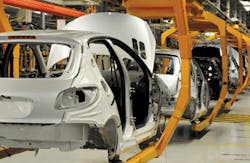Slansky attributes that bounceback to General Motors and Chrysler entering into the U.S. Code’s Title 11, Chapter 11 bankruptcy to reorganize their business affairs and assets. “Ford reinvented itself, too,” he adds.
To facilitate recovery, the “Detroit Three” didn’t just trim production rates, but also eliminated some nameplate brands, Slansky explains. For example, GM rid itself of Pontiac, Saturn, Hummer and Saab. Ford’s done well, he says, because they closed plants and initiated a program to reduce 180 nameplates to approximately 20. And unlike GM and Chrysler, who accepted bailout money from the U.S. government, Ford borrowed money on its own. The current payoff means Ford is now the U.S. market leader, he adds.
Beyond such rosy news, though, Slansky believes a milestone global trend has occurred. “For the first time, in 2010, emerging auto markets accounted for more than one half of global light-vehicle sales (51 percent), clearly indicating the shift in power in the global automotive market that has been taking place for the last five years,” he says. Writing in the March 2011 ARC Insights “Global Automotive Trends for 2011 and Beyond” report, he forecasts the momentum of these emerging markets will continue throughout 2011 and into this decade. “Russia could very well be the next major automotive manufacturing center for foreign car makers,” he adds.
100 million units
Looking forward, the global market for new cars is projected to be greater than 100 million units over the next five to 10 years, Slansky says. Much of that demand will come from emerging economies, especially in Asia-Pacific Action Committee (APAC) countries, he predicts. For example, in an Aug. 4, 2011 press release, GM Chairman and Chief Executive Officer Dan Akerson said, “We’re preparing to launch more new products this year, including the Baojun 630 in China.”
Ford’s also an example of expansion into the China-Asia market. In late July, the company announced a $350 million investment with joint-venture partners to build Ford’s first transmission plant in China. It will have an initial capacity of 400,000 six-speed transmissions. Ford announced plans to add 340 new dealerships in China by 2015, and committed to build a next-generation small SUV in China. The company also announced $72 million investment to increase production capacity at the Chennai Engine Plant in India.
Vehicles consumers want
The industry still faces one significant obstacle, however: getting vehicles to market that consumers will buy. Slansky believes the industry finds itself transitioning with regard to use of fossil fuels vs. electric power vehicles. For example, in North America, but especially the United States, urbanization will drive the use of electric vehicles, he thinks. But he also believes almost all use of electric vehicles in the United States will be exclusive to urban areas. That means about 50 percent of the U.S. population, living in rural areas, likely will not purchase such vehicles.
Nonetheless, one current constraint for electric vehicles is battery technology, Slansky explains. “Even with lithium-cadmium technology, our battery technology today is still pretty crude. They’re frantically working to solve that in Europe,” he says. The two outstanding issues are energy storage and range, he notes, noting battery replacement is a significant price component in electric cars.
Gasoline-powered vehicles face their own critical energy constraint. Slansky wonders what will be the pain threshold of gasoline price in the U.S.: $4 per gallon, or $5 or $6, or even higher? Will it be determined by actual supply and demand? He asks the latter because, as he observes, speculation currently drives fuel prices. Regardless, more vehicles with higher miles-per-gallon (mpg) ratings will be demanded. “Right now, you’re seeing Korean cars such as Kia and Hyundai that give 40 mpg,” he remarks.
Substitutes for gasoline-powered vehicles might be high-mileage diesel-powered passenger vehicles that penetrate the U.S. automotive market. “Volkswagen is now trying to push their high-mileage diesels in the United States,” Slansky says. This push is part of the German automaker’s desire to be the world’s largest carmaker by 2018, he adds.
But as Slansky noted optimistically in the ARC Insight, while there may be a slight slowing of world markets in 2011, the rest of the decade looks to continue on a robust growth trend. He emphasizes the auto market’s resilience, as well as global emerging markets driving the industry. That GM states China, not the United States, is now its largest national market points to the industry’s new global path.
ARC Advisory Group ARC www.arcweb.com
C. Kenna Amos, [email protected], is an Automation World Contributing Editor.
>> Read how GM and ABB Group are looking at ways to extend an electric vehicle's lifecycle after the auto expires.
Subscribe to Automation World's RSS Feeds for Columns & Departments
